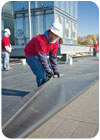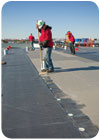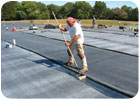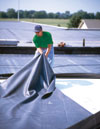EPDM Systems
For all the changes in the roofing industry, EPDM is the homegrown original formula for single-ply membranes. It’s been 40 years since this newcomer emerged with a radical method of waterproofing a building that saved money and could elongate with structural stresses and cope with inclement weather.

 For all the changes in the roofing industry, EPDM is the homegrown original formula for single-ply membranes. It’s been 40 years since this newcomer emerged with a radical method of waterproofing a building that saved money and could elongate with structural stresses and cope with inclement weather.
For all the changes in the roofing industry, EPDM is the homegrown original formula for single-ply membranes. It’s been 40 years since this newcomer emerged with a radical method of waterproofing a building that saved money and could elongate with structural stresses and cope with inclement weather.
The dynamics that brought EPDM to this point are rather unique. As it came into the market, a new sales and marketing force had to be developed, along with new installation techniques using strange equipment that was more familiar to carpet installers than roofers.
There were growing pains as sales went through the roof, but the innovation, performance and service offered by aggressive competitors helped to reshape how roofing was made, sold and installed.
“I think where EPDM is now in the industry, it probably deserves its place there,” says Walt Rossiter, technical director for the Roof Consultants Institute and former researcher at the National Bureau of Standards (NBS). “One of the things I learned very early on is that EPDM is a very stable rubber. It has to be formulated well, to be sure.”

“First cost was so important back in the ’70s,” he recalls. “That was probably what got the [single-ply] industry on its way.”
One reaction from the BUR industry was a two-ply system that quickly turned sour due to large numbers of failures. EPDM roofing also had a number of failures, but it wasn’t due to the membrane. The difficulty was in creating long-term seams. The National Roofing Contractors Association’s Project Pinpoint showed seam failures to be the No. 1 complaint with EPDM. After many steps in evolution - including an infamous experiment with non-penetrating fasteners - butyl based tapes have become the industry standard since their introduction in the 1990s.
Rossiter, who spent years testing and writing about elastomeric seams, says that vulcanized elastomers are durable to weathering but difficult for bonding.
“They certainly knew that seams were going to be a challenge,” says Rossiter about the EPDM producers. “The EPDM industry did stand behind their product to an extent.”

As expected, the membranes held up to weather, especially the Snow Belt, where splits were a problem for many BURs. The ERA estimates that one billion square feet of rubber roofs are installed in the United States each year, with over 20 billion total square feet in service today. Hutchinson knows installers that don’t wear boots to work and haven’t seen a BUR in 10 years.
“I’ve used it for years,” he says. “The Chicagoland area is blessed with some really good contractors.” He’s currently working on a 100,000-square-foot roofing project for a school in Deerfield, Ill., complete with 30 sheets of drawings. He’s added drains, raised edges and has come across HVAC nightmares that past contractors have neglected to address, including 14 inches of coal tar roofing. Hutchinson’s prescription for the roof is an asphalt base sheet with a mineral-surfaced modified bitumen. On top is tapered isoboard set in hot asphalt and covered with DensDeck. The system is then capped with a fully adhered 60- and 90-mil EPDM membrane. It comes with a 20-year warranty and the minimum R-value for the system is 30, which meets the stringent requirements in the Chicago Building Energy Code passed in 2001.
SPRI is tackling the technical issues of green roofing because current code requirements mean mandatory testing for events like fire and high winds. The study of how a garden roof is affected by fire is as new as the vegetation that grows there, but UL and FM testing is geared towards static roof environments that don’t grow things (at least not on purpose).
However, EPDM and single plies have been down this road before. Application methods like fully adhered or mechanically attached membranes had to undergo rigorous scrutiny and hundreds of code bodies had to be convinced, one at a time. With (mostly) uniform codes throughout the country, innovations can be more readily absorbed.
While features like hail and wind resistance were already integral to EPDM membranes, a major innovation that has been sought after for years has been rolled out recently: pre-applied tape. Finally, roofing contractors can enjoy factory-applied adhesive to make for even faster installation. It is reminiscent of the peel-and-stick modified bitumen products that are showing up as an underlayment on more and more roofs.
Through it all, EPDM has rolled with the punches to become a mainstay and continues to meet challenges like new environmental standards. Volatile organic compounds (VOC) are being limited in a growing number of municipalities, even though roofing is generally exempt. Hutchinson knows about demanding construction schedules but has to intervene when weather conditions prohibit certain products and applications.
“People are putting roofs on today,” he observes on a day in early December with freezing rain. “How in the heck can you use water-based adhesives in 26-degree weather? You’ve got to communicate to the general contractor how to install it properly.”
“Given the widespread use of EPDM over the past 40 years, we recognize that a significant amount of membrane could end up in a recycling pipeline,” says Jim Jannasch, EPDM Product Manager for Firestone Building Products Company and a member of ERA’s Technical Committee. “We therefore need to determine what steps need to be taken to make sure the recycling effort fits the economic and logistic standards of contractors and building owners.”
Firestone and Carlisle accept recycled EPDM roofs and preliminary plans are to construct walk pads out of the recycled materials. Sustainability will only grow as an issue, particularly when a tight market for petrochemicals may exist for the long term.
EPDM roof systems were made possible by curious chemists across the United States, who continue to address challenges such as sustainability in the 21st Century. “I have great faith in American chemists to do this,” says Rossiter. “Look at all of the great products we use.”


EPDM (ethylene propylene diene monomer) has the ability to elongate to accommodate building movement and cope with inclement weather. (Photos courtesy of Firestone Building Products.)
The dynamics that brought EPDM to this point are rather unique. As it came into the market, a new sales and marketing force had to be developed, along with new installation techniques using strange equipment that was more familiar to carpet installers than roofers.
There were growing pains as sales went through the roof, but the innovation, performance and service offered by aggressive competitors helped to reshape how roofing was made, sold and installed.
“I think where EPDM is now in the industry, it probably deserves its place there,” says Walt Rossiter, technical director for the Roof Consultants Institute and former researcher at the National Bureau of Standards (NBS). “One of the things I learned very early on is that EPDM is a very stable rubber. It has to be formulated well, to be sure.”

Proper application of the seams is a crucial component in the installation of EPDM systems. (Photo courtesy of ERA.)
New Heights
When Walt Rossiter came to the National Institute of Standards and Technology (now the NBS) in 1970, the only real solution for “flat” roofs was a built-up roof using asphalt or coal tar. The organic chemist with a Ph.D. from University of California at Santa Barbara was asked to look at spray foam roofing at the request of the U.S. Army Corps of Engineers. His curiosity lead to compiling lists of new roofing manufacturers, and after noticing that Carlisle’s plant was nearby, he took his first tour to understand how 45 millimeters of unreinforced rubber could hold its water. His chemistry background told him that properly formulated EPDM would weather the elements very well. The cost was competitive enough to go after the king of roofing, BUR, whose asphalt supplies were getting more expensive with sporadic quality thanks to the OPEC embargoes. Rossiter remembers watching how building owners were willing to give the new membrane a try in order to save money.“First cost was so important back in the ’70s,” he recalls. “That was probably what got the [single-ply] industry on its way.”
One reaction from the BUR industry was a two-ply system that quickly turned sour due to large numbers of failures. EPDM roofing also had a number of failures, but it wasn’t due to the membrane. The difficulty was in creating long-term seams. The National Roofing Contractors Association’s Project Pinpoint showed seam failures to be the No. 1 complaint with EPDM. After many steps in evolution - including an infamous experiment with non-penetrating fasteners - butyl based tapes have become the industry standard since their introduction in the 1990s.
Rossiter, who spent years testing and writing about elastomeric seams, says that vulcanized elastomers are durable to weathering but difficult for bonding.
“They certainly knew that seams were going to be a challenge,” says Rossiter about the EPDM producers. “The EPDM industry did stand behind their product to an extent.”

The EPDM Roofing Association has seen promising results in recycling programs focusing on EPDM roofs. (Photo courtesy of ERA.)
Seams Great
“I’ve always had great success with adhesive seams,” says Tom Hutchinson, a roof consultant based in Chicago and technical consultant for the EPDM Roofing Association (ERA). He’s been on roofs he’s specified 15 years earlier that are leaking, but fixable. “The membrane itself was in great shape,” he says. “You don’t have to replace the roof. Just repair the seams and replace the base flashing.”As expected, the membranes held up to weather, especially the Snow Belt, where splits were a problem for many BURs. The ERA estimates that one billion square feet of rubber roofs are installed in the United States each year, with over 20 billion total square feet in service today. Hutchinson knows installers that don’t wear boots to work and haven’t seen a BUR in 10 years.
“I’ve used it for years,” he says. “The Chicagoland area is blessed with some really good contractors.” He’s currently working on a 100,000-square-foot roofing project for a school in Deerfield, Ill., complete with 30 sheets of drawings. He’s added drains, raised edges and has come across HVAC nightmares that past contractors have neglected to address, including 14 inches of coal tar roofing. Hutchinson’s prescription for the roof is an asphalt base sheet with a mineral-surfaced modified bitumen. On top is tapered isoboard set in hot asphalt and covered with DensDeck. The system is then capped with a fully adhered 60- and 90-mil EPDM membrane. It comes with a 20-year warranty and the minimum R-value for the system is 30, which meets the stringent requirements in the Chicago Building Energy Code passed in 2001.
Roll With the Punches
At first it seemed that white roofs would win the battle for reflectivity as part of the cool roofing movement to lower energy costs for buildings. White colors reflect more solar heat than dark membranes like EPDM, but research has shown factors like ballast and insulation can offset energy losses. Mike Ennis, technical director for the Single Ply Roofing Institute (SPRI), says that stone ballast - originally meant as a cheap method to hold down the loosely laid roofs - generally retains its reflective properties longer than white membranes. “They’ve demonstrated comparable energy savings to white membranes after the white membrane has aged for a few years,” he says, adding that there are other environmental benefits. “EPDM has been a really good membrane to use in the green type of systems.”SPRI is tackling the technical issues of green roofing because current code requirements mean mandatory testing for events like fire and high winds. The study of how a garden roof is affected by fire is as new as the vegetation that grows there, but UL and FM testing is geared towards static roof environments that don’t grow things (at least not on purpose).
However, EPDM and single plies have been down this road before. Application methods like fully adhered or mechanically attached membranes had to undergo rigorous scrutiny and hundreds of code bodies had to be convinced, one at a time. With (mostly) uniform codes throughout the country, innovations can be more readily absorbed.
While features like hail and wind resistance were already integral to EPDM membranes, a major innovation that has been sought after for years has been rolled out recently: pre-applied tape. Finally, roofing contractors can enjoy factory-applied adhesive to make for even faster installation. It is reminiscent of the peel-and-stick modified bitumen products that are showing up as an underlayment on more and more roofs.
Through it all, EPDM has rolled with the punches to become a mainstay and continues to meet challenges like new environmental standards. Volatile organic compounds (VOC) are being limited in a growing number of municipalities, even though roofing is generally exempt. Hutchinson knows about demanding construction schedules but has to intervene when weather conditions prohibit certain products and applications.
“People are putting roofs on today,” he observes on a day in early December with freezing rain. “How in the heck can you use water-based adhesives in 26-degree weather? You’ve got to communicate to the general contractor how to install it properly.”
Coming Down
With all of that EPDM roofing out there, the issue of recycling comes up. Technically, rubber can be used repeatedly, but the economic conditions allowing the reuse of this product haven’t existed until recently. The ERA has been researching the prospects for about two years and has some promising results (See Roofing Contractor, Nov. 2007, page 72). Used membranes can be ground into small granules while issues like debris, end use and feasibility are sorted out. Results were not available as of press time, but the association was on schedule to have removed, transported and reused one million square feet of used EPDM roofing.“Given the widespread use of EPDM over the past 40 years, we recognize that a significant amount of membrane could end up in a recycling pipeline,” says Jim Jannasch, EPDM Product Manager for Firestone Building Products Company and a member of ERA’s Technical Committee. “We therefore need to determine what steps need to be taken to make sure the recycling effort fits the economic and logistic standards of contractors and building owners.”
Firestone and Carlisle accept recycled EPDM roofs and preliminary plans are to construct walk pads out of the recycled materials. Sustainability will only grow as an issue, particularly when a tight market for petrochemicals may exist for the long term.
EPDM roof systems were made possible by curious chemists across the United States, who continue to address challenges such as sustainability in the 21st Century. “I have great faith in American chemists to do this,” says Rossiter. “Look at all of the great products we use.”
Looking for a reprint of this article?
From high-res PDFs to custom plaques, order your copy today!




